If we enter a dark room, the objects present in the room are not visible. However, if we switch on a bulb, everything in the room becomes visible. Why?
The bulb gives out an invisible energy called light. When this energy falls on the objects in the room, it bounces off from the surface of objects. When this energy enters our eyes, the eyes sense it and send a message to the brain. It is finally, the brain which really sees the objects. Eyes are only an aid in seeing the objects around us.
Why do we say that light is invisible ? Well, when light energy falls on the objects, we really do not see it. When energy bounces off from the surface of objects and enters our eyes, the sensation produced by this energy, helps our brain to see. Thus, to sum up we can say.
Light is an invisible energy, which causes in us the sensation of vision. When the light falls on any object, it bounces off from the surface of the object in all directions. This is called scattering of light.
Light is form of energy which enables us to see objects which emit or reflect light.
Light is a type of (form of) energy which can produce sensation in our eyes. So we can experience the sensation of vision.
It travel in straight line in form of particles and waves. With the help of light we see all colours of nature.
Our eyes are mostly sensitive for yellow colour and least sensitive for violet and red colour. Due to this reason commercial vehicle's are painted with yellow colour, sodium lamps are used in road lights.
It is a branch of physics which deals with the study of light. It is mainly divided into three parts :
(a) Geometrical optics or ray optics: It deals with the reflection and refraction of light.
(b) Wave or physical optics : It is concerned with nature of light and deals with interference, diffraction and polarisation.
(c) Quantum optics: It deals with the interaction of light with the atomic entities of matter such as photo electric effect, atomic excitation etc.
(a) Particle Nature of Light (Newton's corpuscular theory) :
According to Newton light travels in space with a great speed as a stream of very small particles called corpuscles.
According to this theory reflection and refraction of light are explained while this theory was failed to explain interference of light and diffraction of light. So wave theory of light was discovered.
(b) Wave Nature of Light:
Huygen consider the light remains in the form of mechanical rays and he consider a hypothetical medium like ether for propagation of light waves:
So, light waves are declared electromagnetic waves so there is no need of medium for the propagation of these waves. They can travel in vacuum also. The speed of these waves in air or in vacuum is maximum i.e., 3 × 108 m/s.
Photoelectric effect was not explained with the help of wave theory, so Planck gave a new theory which was known as quantum theory of light.
This theory is failed to explain photo electric effect.
(c) Quantum Theory of Light:
According to 'Planck' light travels in the form of energy packets or quanta's of energy called photons. The rest mass of photon is zero . Each quanta carries energy E =hn.
h ® Planck's constant = 6.6 x 10-34 J-s.
n ® frequency of light
Some phenomenons like interference of light, diffraction of light are explained with the help of wave theory but wave theory was failed to explain the photo electric effect of light. It was explained with the help of quantum theory. So, light has dual nature.
(d) Dual Nature of Light:
De Broglie explained the dual nature of light, i.e wave nature and particle nature.
(i) wave nature: Light is electromagnetic waves it is transverse in nature and propagate in vacuum (ii) Particle or Photon Nature : With the help of this theory Einstein explained the photo electric effect.

A body which emits light or reflect the light falling on it in all possible direction is said to be the source of light. The source can be point one or an extended one. The sources of light are of two types :
(a) Luminous Source :
Any object which by itself emits light is called as a luminous source.
e.g.: Sun and stars (natural luminous sources), electric lamps, candles and lanterns (artificial luminous sources).
(b) Non-luminous Source :
Those objects which do not emit light but become visible only when light from luminous objects falls on them. They are called non-luminous sources.
e.g.: Moon, planets (natural non-luminous sources), wood, table (artificial non-luminous sources).
Substance through which light propagates or tends to propagate is called medium of light.
(i) Transparent Object :
Bodies that allow light to be pass through them i.e. transmit light through them, are called transparent bodies.
e.g.: Glass, water, air etc.
(ii) Translucent Object :
Bodies that can transmit only a part of light through them are called translucent objects.
e.g.: Frosted or ground glass, greased paper, paraffin wax.
(iii) Opaque Object :
Bodies that do not allow light to pass through them at all are said to be opaque object.
Eg. Chair, desk etc.
Note : Depending on composition optical medium are divided into two type.
(i) Homogeneous medium : An optical medium which has a uniform composition throughout is called homogeneous medium.
E.g. Vacuum, distilled water, pure alcohol, glass, plastics, diamond, etc.
(ii) Heterogeneous medium : An optical medium which has different composition at different points is called heterogeneous medium.
Eg. Air, muddy water, fog, mist, etc.
When light travelling in one medium falls on the surface of a second medium the following three effects may occur :
(i) A part of the incident light is turned back into the first medium. This is called reflection of light.
(ii) A part of the incident light is transmitted into the second medium along a changed direction. This is called refraction of light.
(iii) The remaining third part of light energy is absorbed by the second medium. This is called absorption of light.

Some common characteristics of light are given below :
(i) Light has dual nature i.e both wave and particle, nature.
(ii) Light is an electromagnetic wave.
(iii) Light does not require material medium for its propagation i.e. light can travel through vacuum.
(iv) The speed of light in free space (vacuum) is 3 × 108 m/s. lts speed is marginally less in air. lts speed decreases considerably in glass or water.
(v) Light undergoes reflection from polished surfaces such as mirrors, etc.
(vi) Light undergoes refraction when it goes from one medium to another.
Ray optics treats propagation of light in terms of rays and is valid only if the size of the obstacle is much greater than the wavelength of light. It concern with the image formation and deals with the study of the simply facts such as rectilinear propagation, laws of reflection and refraction by geometrical methods.
A ray can be defined as an imaginary line drawn in the direction in which light is travelling. Light behaves as a stream of energy propagated along the direction of rays. The rays are directed outward from the source of light in straight lines.
A beam of light is a collection of these rays. There are mainly three types of beams.
(i) Parallel beam of Light :
A search light and the headlight of a vehicle emit a parallel beam of light. The source of light at a very large distance like sun effectively gives a parallel beam.
![]()
(ii) Divergent beam of Light :
The rays going out from a point source generally form a divergent beam.

(iii) Convergent beam of Light :
A beam of light that is going to meet (or converge) at a point is known as a convergent beam. A parallel beam of light after passing through a convex lens becomes a convergent beam.

How we see ?
When a light ray is falling (strike) on the surface of any object which reflect and reached to our eyes. Due to this our eyes feel a sensation then we see the object.
When rays of light falls on any object it return back in the same medium from the surface this phenomenon is called reflection of light. Due to reflection of light we can see all the nature.
Þ Incident ray
The ray of light which falls on a polished surface (or a mirror) is called the incident ray of light.
Þ Reflected ray
The ray of light which gets reflected from a polished surface (or a mirror) is called the reflected ray of light.
Þ Normal
The normal is a line at right angle to the reflecting surface.
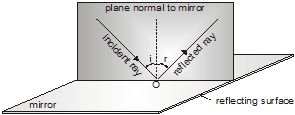
(i) The incident ray, the reflected ray and the normal to the surface at the point of incidence all lie in the same plane.
(ii) The angle of incidence (i) is always equal to the angle of reflection (r) i.e. i = r

When a ray of light falls on a mirror normally or at right angle it gets reflected back along the same path.

(i) A ray of light striking the surface normally retraces its path.
When a ray of light strikes a surface normally, then angle of incidence is zero i.e. Ði = 0. According to the law of reflection, Ðr = Ði, Ðr = 0 i.e. the reflected ray is also perpendicular to the surface. Thus an incident ray normal to the surface (i.e. perpendicular to the surface) retraces its path as shown in figure.

(ii) Laws of reflection are also obeyed when light is reflected from the spherical or curved surface as shown in figure (a) and (b)
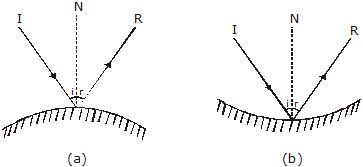
Depending on the nature of the reflecting surface there are two types of reflection :-
(i) Regular (specular) reflection (ii) Irregular (diffused) reflection
The phenomenon due to which a parallel beam of light travelling through a certain medium, on striking become parallel beam, in some other fixed direction is called Regular reflection.
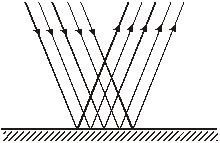
Regular reflection takes place from the objects like looking glass, still water, oil, highly polished metals etc.
Regular reflection is useful in the formation of images, e.g., we can see our face in a mirror only on account of regular reflection. However, it causes a very strong glare in our eyes.
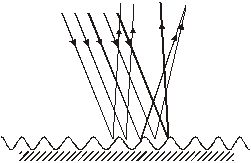
The phenomenon due to which a parallel beam of light, travelling through some medium, gets reflected in various possible directions, on striking some rough surface is called irregular reflection or diffused reflection.
The reflection which takes places from ground, walls, trees, suspended particles in air, and a variety of other objects, which are not very smooth, is irregular reflection.
Irregular reflection helps in spreading light energy over a vast region and also decreases its intensity. Thus, it helps in the general illumination of places and helps us to see things around us.
NOTE : Laws of reflection are always valid no matter whether reflection is regular or irregular.
Definition :
In simplest terms, rectilinear propagation of light means that light energy travels in straight lines.
(i) When the sunlight enters through a small hole in a dark room, it appears to travel in straight lines.
(ii) The light emitted by the head light of a scooter at night appears to travel in straight lines.
(iii) lf we almost close our eyes and try to look towards a lighted bulb, it appears to give light in the form of straight lines, which travel in various direction.
Take three wooden upright A, B and C having a small hole in the middle, such that the holes are at the same height from the base. Arrange the uprights along the edge of a table, such that holes are in the same straight line. Place a lighted candle towards the upright A, such that it is facing the hole. Look through the hole of upright C. The candle flame is clearly visible.
Now displace upright B, slightly towards right or left. It is seen that candle flame is no longer visible. This shows that light travels in straight lines.
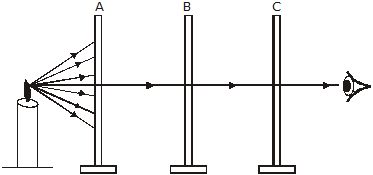
A smooth, highly polished reflecting surface is called a mirror.
When a glass plate is polished on one sided with reflecting material such silver or nickel then is becomes a mirror.
From the reflecting surface of mirror there are two types of mirror.
A highly polished plane surface is called a plane mirror or if a flat (totally plane) surface of a glass plate is polished one side of reflecting material is called plane mirror.

Consider a plane mirror XY. Let a point object O is placed in front of the mirror as shown in figure.
A ray OA is incident on the plane mirror at right angle to the mirror (i.e. Ði = 0). The reflection takes place at A and the reflected ray retraces its path along AO.
( Ðr = 0)
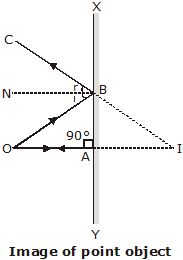
Another ray starting from O incident at point B on the mirror and the reflected ray goes along BC such that Ði = Ðr. The reflected rays AO and BC never meet each other.
When the reflected rays AO and BC are produced backward, they appear to be coming from point I. ln other words, reflected rays appear to diverge from point I. So point I is the virtual image of a point object O. Since there is no actual meeting of rays at point I.
The position of image I is as far behind the plane mirror as the position of the object O in front of the plane mirror.
i.e. OA = IA (see in figure).
Consider an extended object OA (say a pin) placed in front of a plane mirror XY at O. Each point of the object (i.e., pin) acts like a point source of light. The virtual image of each point of the extended object is formed behind the plane mirror as shown in figure. IA’ is the virtual image of an extended object OA.
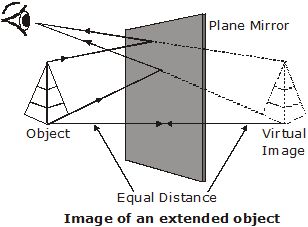
Consider an extended object OA (say a pin ) placed in front of a plane mirror XY at O . Each point of the object(i.e.,pin) acts like a point source of light . The virtual image of each point of the extended object is formed behind the plane mirror as shown is fingure . IA: is the virtual image of an extended object OA .
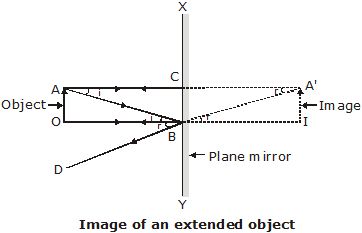
In D’s BAC and BA’C
Ði = Ðr, ÐACB = ÐA’CB = 90º,
ÐABC = ÐA’BC
Also BC is common
DABC and DA’BC are congruent by ASA
So AC = A’C i.e. perpendicular distance of object from the mirror is equal to the perpendicular distance of image from the mirror
In D’s OBA and IBA’
ÐBOA = ÐBIA’ = 90º
ÐOBA = ÐIBA’ and so ÐOAB = ÐIA’B
Further as AB = BA’ so they are also congruent by ASA
Thus OA = IA’
i.e., Size of object = Size of image
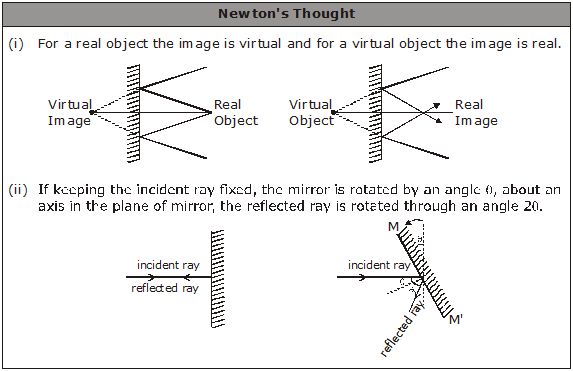
When we look through the plane mirror, we find that the right eye of the image of our face appears as the left eye and the left eye of the image appears as the right eye. In other words, the right side of the object appears as the left side of the image and vice versa.
This effect is known as lateral inversion.
The exchange of the right and left sides of an object and its image is known as lateral inversion.
Write a letter P on a card. Place it in front of a plane mirror. We find that letter appears as q, i.e. right of letter. P appears as left side of the image of letter P as shown in figure.
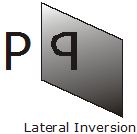
Lateral inversion is due to the fact that the image of points on the object which are at a lesser distance from the mirror are formed nearer in the mirror and for those the mirror are formed nearer in the mirror and for those points which are at some more distance will be formed at larger distance. So the image appears to be laterally inverted.
(i) The image formed by a plane mirror is virtual.
(ii) The image formed by a plane mirror is erect.
(iii) The size of the image formed by a plane mirror is same as that of the size of the object. lf object is 10 cm high, then the image of this object will also be 10 cm high.
(iv) The image formed by a plane mirror is at the same distance behind the mirror as the object is in front of it. Suppose, an object is placed at 5 cm in front of a plane mirror then its image will be 5 cm behind the plane mirror.
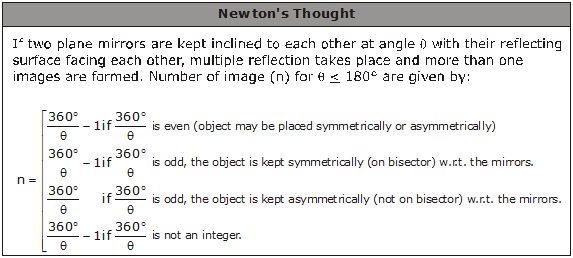
A mirror whose polished, reflecting surface is a part of hollow sphere of glass is called a spherical mirror. For a spherical mirror, one of the two curved surfaces is coated with a thin layer of silver followed by a coating of red lead oxide paint. Thus one side of the spherical mirror is made opaque and the other side acts as a reflecting surface.
For the polishing side there are two type of spherical mirror.
(A) Concave (Converging) mirror : A spherical mirror whose inner hollow surface is the reflecting surface.
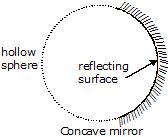
(B) Convex (diverging) mirror : A spherical mirror whose outer bulging out surface is the reflecting surface.
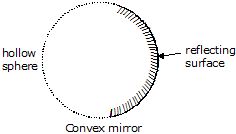
(a) Aperture : The effective width of a spherical mirror from which reflection can take place is called its aperture AA' & BB'.
The line joining the end points of a spherical mirror is called the aperture or linear aperture.


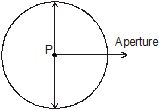
(b) Pole (Vertex) : The centre of a spherical mirror is called its pole it is denoted by letter P.
 +
+
(c) Centre of curvature : The centre of the hollow sphere of which the spherical mirror is a part is called centre of curvature. It is denoted by letter C.
(d) Radius of curvature : The radius of the hollow sphere of which the spherical mirror is a part called the radius of curvature (R).

(e) Principal axis : The straight line passing through the centre of curvature C and the pole P of the spherical mirror.


(f) Normal : The normal at any point of the spherical mirror is the straight line obtained by joining that point with the centre of curvature C of the mirror.
(g) Principal focus or focus : The point on the principal axis where all the rays coming from infinity (parallel rays) after reflection either actually meets or appears to meet is called the focus (or focal point) of the mirror. It is denoted by letter F.

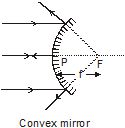
(h) Focal length :– The distance between the pole (P) and the focus (F) is called focal length (f) and
(i) Focal plane :- An imaginary plane passing through the focus and at right angles to the principal axis.
(j) paraxial Rays : The ray which have very small angle of incidence are known as paraxial rays.
(k) Real Image :- When the rays of light after getting reflected from a mirror (or after getting refracted from a lens) – actually meet at a point, a real image is formed. A real image can be obtained on a screen.
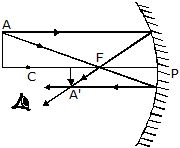
(l) Virtual Image : When the rays of light after getting reflected from a mirror (or after getting refracted from a lens) appear to meet at a point, a virtual image is formed. Such an image can only be seen through a mirror (or a lens) but cannot be obtained on a screen.
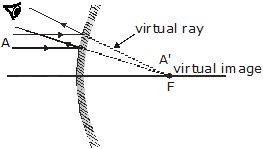
The reflection of light rays and formation of images are shown with the help of ray diagrams. Some typical incident rays and the corresponding reflected rays are shown below.
(i) A ray passing parallel to the principal axis, after reflection from the spherical mirror passes or appears to pass through its focus (by the definition of focus)

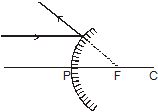
(ii) A ray passing through or directed towards focus, after reflection from the spherical mirror becomes parallel to the principal axis (by the principal of reversibility of light).

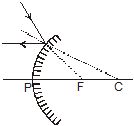
(iii) A ray passing through or directed towards the centre of curvature, after reflection from the spherical mirror, retraces its path (as for it Ði = 0 and so Ð r = 0)
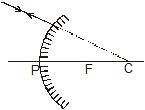

(iv) It is easy to make the ray tracing of a ray incident at the pole as shown in below.
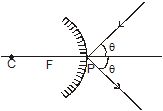
Formation of images by concave mirror
(i) When the object is placed between the pole and the focus, then the image formed is virtual, erect and magnified.
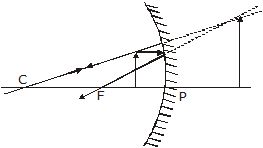
(ii) When the object is placed at the focus then the image is formed at infinity. The image is extremely magnified.
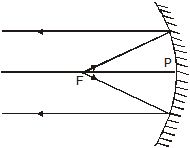
(iii) When the object is placed between the focus and the centre of curvature then the image is formed beyond the centre of curvature. The image formed is real, inverted and bigger than the object.
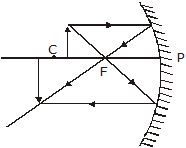
(iv) When the object is placed at the centre of curvature, then the image is formed is formed at the centre of curvature.
The image formed is real, inverted and equal to the size of the object.
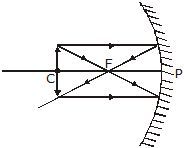
(v) When the object is placed beyond the centre of curvature, then the image is formed between the focus and centre of curvature. The image formed is real, inverted and diminished.
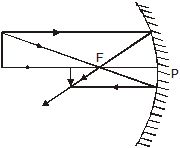
(vi) When the object is placed at infinity then the image is formed at the focus. The image formed is real, inverted and extremely diminished in size.
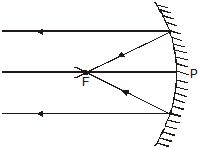
S. No. Position of the Position of the Nature & size Ray diagram
object image of the image
(1) At infinity. At focus F Real, inverted
and highly
diminished.
(point size)
(2) Between infinity Between C & F Real, inverted
and C and smaller than
the object
(3) At C At C Real, inverted
and same size.
(4) Between Between C Real, inverted
C & F and infinity. and enlarged.
(5) At F At infinity. Real, inverted
and infinitely large.
(6) Between focus Behind the Virtual, erect
and pole mirror. and enlarged.
(i) It is used as a shaving mirror.
(ii) It is used as a reflector in the head light of vehicles.
(iii) It is used by doctor to focus a parallel beam of light on a small area.
(i) When the object is at infinity
When the rays of light coming (diverging) from an object, situated at infinity are always parallel these parallel rays, strike the convex mirror, and reflected to diverge outward from convex mirror. These rays seems (appear) to come from focus.
The characteristics of the image is virtual, erect, diminished to a point and formed at principal focus behind the convex mirror.
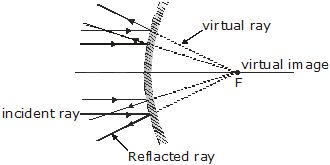
(ii) When the object is at a finite distance from the pole then the image is formed between pole and principal focus behind the convex mirror and image is virtual, erect and diminished.
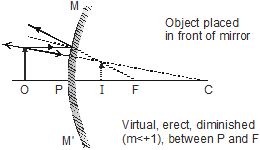
Note :
There are only two position of the object for showing the image formed by a convex mirror that is –
(i) When the object is at a infinity.
(ii) When the object is at a finite distance from the pole of the convex mirror. Beside this positions are not possible because the focus and the centre of curvature is behind the reflecting surface of the convex mirror.

Uses of Convex mirror
(i) It is used as a rear view mirror in automobile.
(ii) It is used as a reflector for street light.
Note : A plane mirror is not useful as a rear view mirror, because its field of view is very small.
¥ Whenever and wherever possible the ray of light is taken to travel from left to right.
¥ The distances above principal axis are taken to be positive while below it negative.
¥ Along principal axis, distances are measured from the pole and in the direction of light are taken to be positive while opposite to it is negative.

Ex.1 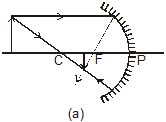
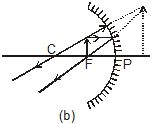
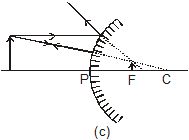
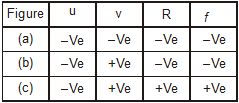
Important Points Regarding Sign Convention :
In this sign convention, focal length of a concave mirror is always negative while the focal length of a convex mirror is always positive.
Assume the pole to be (0, 0).
Relation between f and R for the spherical mirror
If Q is near to line P then from DQCP tanq ~ q =
and from DQFP tan2q ~ 2q =
so Þ f =
Relation between u,v and f for curved mirror
If an object is placed at a distance u from the pole of a mirror and its image is formed at a distance v (from the pole)
If angle is very small : , ,
from DCMO, b = a + q Þ q = b – a
from DCMI, g = b + q Þ q = g – b
so we can write b – a = g – b Þ 2b = g + a
Þ
Linear magnification
DABP and DA'B'P are similar Þ
Magnification Þ
The power of a mirror is defined as ![]()
In convex mirror the field of view is increased as compared to plane mirror.
It is used as rear-view mirror in vehicles.
Concave mirrors give enlarged, erect and virtual image, so these are used by dentists for examining teeth. due to their converging property concave mirrors are also used as reflectors in automobile head lights and search lights
A real image can be taken on a screen, but a virtual image cannot be taken on a screen.
As focal length of a spherical mirror depends only on the radius of mirror and is independent of wavelength of light and refractive index of medium so the focal length of a spherical mirror in air or water and for red or blue light is same.
The relation between the distance of the object from the pole of the spherical mirror (u), the distance of the image from the pole of the spherical mirror (v) and its focal length (f) is given by the mathematical formula :
![]()
It must be remembered that focal length (f) of a spherical mirror is half the radius of curvature (R).
Thus, (i) R = 2f, (ii) f =
(i) Put the correct signs of known variables according to the sign convention.
(ii) Do not put the sign of an unknown variable. The sign will be automatically come up during calculations.
(iii) If the calculated sign turns out to be positive, then the variable calculated is behind the mirror. However, if calculated sign turns out to be negative, then variable is to be in front of the mirror.
Linear magnification produced by spherical morrors :
The ratio between the height of the image produced by the spherical morror to the height of the object is called the linear magnification.
Thus, linear magnification = or
As we normally take the object above the principal axis, therefore, h0 is always positive. The real image is always inverted and is formed below the principal axis.
Therefore, hi is always negative. Thus, Linear magnification for real images =is always negative.
In case of virtual image. it is erect and formed above the principal axis. Thus, h0 and hi are both positive.
The linear magnification produced by a spherical mirror is equal to the ratio of the distance of the image from the pole of the mirror (v) to the distance of the object from the pole of the mirror (u) with a minus sign.
Linear magnification, m =– , Thus Linear magnification, m = = –.
(i) Put the correct signs of known variables according to the sign convention.
(ii) If 'm' is known, take the sign for virtual image positive and for real image negative.
(iii) Do not put the sign of unknown variables. The sign will automatically come up during calculations.
Ex.2 Find out the position and type of image formed.
Sol. cm
V = – 15cm (Real image)
Ex.3 Find out the position and type of image formed.
Sol.
V = + 10 (Virtual image)
Ex.4 Findout the position, height and type of image.
Sol.
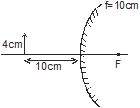
Þ V = + 5cm
Deviation or bending of light rays from their original path while passing from one medium to another is called refraction. It is due to change in speed of light as light passes from one medium to another medium. If the light is incident normally then it goes to the second medium without bending, but still it is called refraction.
Refractive index of a medium is defined as the factor by which speed of light reduces as compared to the speed of light in vacuum.
The refractive index, of medium 2 with respect to medium 1, equals the ratio of the speed of light in medium 1 to its speed in medium 2. Thus,
=
Medium 1 is usually air. When we say that the refractive index of water is 1.33 (or 4/3), it means that the speed of light, in water, is 3/4th of its value in air.
m = =
More (less) refractive index implies less (more) speed of light in that medium, which therefore is called denser (rarer) medium.
NOTE:-
Higher the value of Refractive index denser (optically) is the medium.
Frequency of light does not change during refraction
(a) The incident ray, the normal to any refracting surface at the point of incidence and the refracted ray all lie in the same plane called the plane of incidence or plane of refraction.
(b) for any pair of media and for light of a given wavelength.
This is known as Snell's Law.
Also,
For applying in problems remember
n1 sin i = n2 sin r
= Refractive Index of the second medium with respect to the first medium.
C = speed of light in air (or vacuum) = 3 × 108 m/s.
i & r should be taken from normal.
Special cases :
Normal incidence : i = 0
from Snell's law : r = 0
When light moves from denser to rarer medium it bends away from normal.
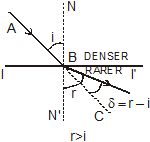
When light moves from rarer to denser medium it bends towards the normal.
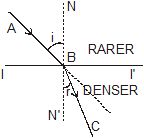
When the object is in denser medium and the observer is in rarer medium (near normal incidence)
When an object O is in denser medium of depth 'd' and absolute refractive index n1 and is viewed almost normally to the surface from the outside rarer medium (r.i = n2), its image is seen at I. which is at a distance d¢ from surface AO is the real depth of the object. AI is the apparent depth of the object. Ol is called apparent shift.
According to Snell's law,
or, (Q i and r are small angles)
=
NOTE:-
1. The above formula is value only for paraxial rays.
2. distances should be taken from surface
3. n2 is the reflective index of the medium, where ray is going and n1 from where ray is coming
When a light ray passes through a glass slab having parallel faces, it gets refracted twice before finally emerging out of it.
First refraction takes place from air to glass.
So, m = ...(i)
The second refraction takes place from glass to air.
So, ...(ii)
From equations (i) and (ii), we get
Þ i = e
Thus, the emergent ray is parallel to the incident ray.
Critical angle is the angle made in denser medium for which the angle of refraction in rarer medium is 90°. When angle in denser medium is more then critical angle the light ray reflects back in denser medium following the laws of reflection and the interface behaves like a perfectly reflecting mirror. In the figure.
O = object
NN¢ = Normal to the interface
II¢ = Interface
C = Critical angle :
AB = reflected ray due to T.I.R.
When i = C then r = 90°
Ex.5 Find the max. angle that can be made in glass medium (m = 1.5) if a light ray is refracted from glass to vacuum.
Sol. 1.5 sin C = 1 sin 90°, where C = critical angle.
sin C = 2/3 Þ C = sin–12/3
¥ Sparkling of diamond
The sparkling of diamond is due to total internal reflection inside it. As refractive index for diamond is 2.5 so qC = 24°. Now the cutting of diamond are such that i > qC. So TIR will take place again and again inside it. The light which beams out from a few places in some specific directions makes it sparkle.
¥ Optical Fibre
In it light through multiple total internal reflections
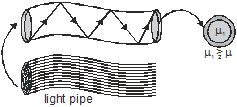
is propagated along the axis of a glass fibre of radius of fewmicrons in which index of refraction of core is greater than that of surroundings.
¥ Mirage and looming
Mirage is caused by total internal reflection in deserts where due to heating of the earth, refractive index of air near the surface of earth becomes lesser than above it. Light from distant objects reaches the surface of earth with i > q C so that TIR will take place and we see the image of an object along with the object as shown in figure.

Similar to 'mirage' in deserts, in polar regions 'looming'

takes place due to TIR. Here m decreases with height and so the image of an object is formed in air if
(i>q C ) as shown in Fig.
• A diver in water at a depth d sees the world outside through a horizontal circle of radius. r = d tan qc.
• For total internal reflection to take place light must be propagating from denser to rarer medium.
• In case of total internal reflection, as all (i.e. 100%) incident light is reflected back into the same medium there is no loss of intensity while in case of reflection from mirror or refraction from lenses there is some of intensity as all light can never be reflected or refracted. This is why images formed by TIR are much brighter than formed by mirrors or lenses.
Lens : A lens is a transparent medium bounded by two refracting surfaces such that at least one of the refracting surfaces is curved. (or spherical)
Types of lenses. : Broadly, lenses are of the following types :

Let us first understand the meanings of a few terms relevant to the lenses.
Centres of curvature : Each of the two surfaces of a spherical lens can be regarded as a part of a sphere. The centres of these two spheres are known as the centres of curvature or the two surfaces of the lens.
Radii of curvature : The radii of the two spheres, of which the lens surfaces are a part of, are known as the radii of curvature or the two surfaces of the lens.

Principal axis : The line joining the centres of curvature of the two surfaces of a lens is known as its principal axis.
Optical centre : The optical centre of a lens is a special point on its principal axis. A ray of light passing through the optical centre of a lens, goes straight through it without undergoing any bending or deviation from its path.
Principal Focus/Focal length : It turns out that if a beam of rays, all parallel to the principal axis of a lens, falls on the lens, they either all converge to a point on its principal axis, or appear to diverge from a point on its principal axis. We call this point as the (second) principal focus of the lens.
The distance of the (second) principal focus from the optical centre of a lens, equals the focal length of the lens.


Three Special Rays for Lenses : We can use the ideas and definitions, outlined above, to draw ray diagrams for lenses. These ray diagrams help us to know the nature, size and position of the image formed when the object is kept at different distances from the lens. We prefer to use two of the three (special) incident rays given below, to draw these ray diagrams.
(i) An incident ray, parallel to the principal axis, passes through (or appears to come from, the (second) principal focus of the lens.
(ii) An incident ray, passing through the optical centre of the lens, goes undeviated from the lens.
(iii) An incident ray, passing through the (first) principal focus of the lens, or directed towards it, becomes parallel to the principal axis after refraction from the lens.
 `
`
Let us now see how we can use any two of these three (special) incident rays to draw ray diagrams, for different object positions, for a convex lens and a concave lens.
A convex lens forms images of different sizes, nature, and at different positions, for objects kept at different distances from its optical centre. We consider the following five cases that cover all possible types of image formed by this lens. The ray diagrams have been drawn using (up to) two of the three (special) rays mentioned above. The characteristics, of the image formed, have been written along with the corresponding ray diagram.
(i) Object at infinity : The image of a very far off object (object at infinity) is a real, diminished and almost point like image. It is formed at the focus of the lens.

(ii) Object beyond the '2F' point of the lens : The image formed here is a real, diminished, inverted image. It is formed between the 'F' and '2F' point of the lens, on its other side (the side opposite to the side on which the object has been put).

(iii) Object at the '2F' point of the lens : The image formed here is a real, inverted image that has the same size as the object. It is formed at the '2F' point, of the lens, on the other side of the lens.

(iv) Object between the '2F' and 'F' point of the lens : The image formed here is a real, inverted and magnified image. It is formed beyond the '2F' point of the lens on its other side.

(v) Object kept at the (first) principal focus or the 'F' point of the lens : The image formed here is taken as a real, inverted and magnified image. It is regarded as formed very far off or at infinity.

(vi) Object between the optical centre and the 'F' point of the lens : The image formed here is a virtual erect and magnified image. It appears to be formed beyond the 'F' point of the lens on the same side as the object is.

Unlike a convex lens, the nature and position of the image, formed by a concave lens, does not depend upon the distance of the object from the lens. A concave lens always forms of virtual, erect and diminished image. Also, the image always appears to be located between the optical centre and the 'F' point of the lens on the same side as the object is. We illustrate these features of the concave lens by drawing 'ray diagrams' for three different distances of the object from the lens.

In all cases, the image formed is a virtual, erect and diminished one. Also, it always appears to be formed between the optical centre and the 'F' point of the lens.
It is the measure of deviation produce by a lens. It is defined as the reciprocal of its focal length in metres. Its unit is Diopter (D) (f should always be in metres.)
Power (P) = ![]()
Power of a convex lens is +ve (As it has a real focus and its focal length measured is +ve.)
Power of a concave lens is –ve (As it has a virtual focus and its focal length measured is –ve.)
NOTE
lf two thin lenses are placed in contact, the combination has a power equal to the algebraic sum of the powers of two lenses, P = P1 + P2
Þ = +
Here, f1 and f2 are the focal length of lenses and f is focal length of combination of lenses.
Relation between object distance u, image distance v and focal length f is :
![]()

Linear magnification (m) is defined as the ratio of the size of the image to the size of the object.
m = = =
also m =
1. An object is placed 12 cm away from the optical centre of a lens. Its image is formed exactly midway between the optical centre and the object :
(i) Draw a ray diagram to show the image formed.
(ii) Calculate the focal length of the lens used.
Sol. (i) The ray diagram is shown below.
The image is virtual, erect and a diminished image.
(ii) Using lens formula
– = , we have
=
= – + = = –
2. Two thin convex lenses of focal lengths 10cm and 20cm are placed in contact. Find the effective power of the combination.
Sol. P = P1 + P2
P = +
= + = 10 + 5 = 15D
3. An illuminated object and a screen are placed 90cm. apart. What is the focal length and nature of the lens required to produce a clear image on the screen, twice the size of the object?
Sol. As the image is real, the lens must be a convex lens and it should be placed between the object and the screen.
Let distance between the object & the convex lens be x
then u = –x, v = 90 – x
Now m = = –2(image is real)
= –2 Þ x = 30
u = –30 cm, v = +60 cm.
Now,
= – = – = + = =
f = 20 cm.
Lenses find a number of uses in our day- to-day life. The simplest of such applications include the magnifying glass, the microscope, the telescope and the photographic camera. And, of course, that wonderful gift of nature to mankind the eye also has a 'built-in' lens that plays a very important role in its functioning.
The Magnifying Glass (The simple Microscope) : The magnifying glass, or a simple microscope, is simply a convex lens of short focal length. We have seen above that the convex lens produces a virtual, erect and magnified image of an object when the object is kept within the focal point of the lens. it turns out that the smaller the focal length of a lens, the more is the magnification produced by it. We often use a (small focal length) convex lens, provided with a frame and a handle, as a simple magnifying glass or as a reading lens. However, we can use such a lens for producing a magnification of 5 to 10 times only.

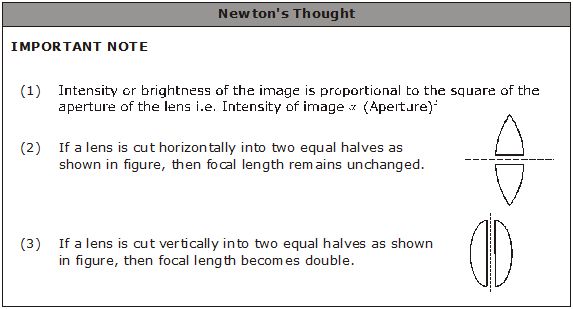
Q.1 Define the principal focus of a concave mirror.
Ans. A point on the principal axis where the parallel rays of light after reflecting from a concave mirror meet.
Q.2 The radius of curvature of a spherical mirror is 20cm. What is focal length?
Ans. Radius of curvature, R = 20cm
Focal length, f = = = 10 cm
Q.3 Name a mirror that can give an erect and magnified image of an object.
Ans. A concave mirror.
Q.4 Why do we prefer a convex mirror as a rear-view mirror in vehicles?
Ans. This because a convex mirror forms an erect and diminished (small in size) images of the objects behind the vehicle and hence the field of view behind the vehicle is increased.
Q.5 Find the focal length of a convex mirror whose radius of curvature is 32 cm.
Ans. R = +32 cm. Therefore, f = R/2 = +3/2 = +16cm
Thus, focal length of the convex mirror = +16cm
Q.6 A concave mirror produces three times magnified (enlarged) real image of an object placed at 10cm in front of it. Where is the image located?
Ans. m = –3,
But m = u/u, so, v = 3u
u = –10cm, v = 3(–10 cm) = –30cm
Thus, the image is located at a distance of 30cm to the left side of the concave mirror.
Q.7 A ray of light travelling in air enters obliquely into water. Does the light ray bend towards the normal or away from the normal? Why?
Ans. The ray of light bends towards the normal because the speed of light decreases when it goes from air (rarer medium) into water (denser medium).
Q.8 Light enters from air to glass having refractive index 1.50. What is the speed of light in the glass? The speed of light in vacuum in 3 × 108 ms–1.
Ans. n = u = = 2 × 108 ms–1
Thus, speed of light in glass = 2 × 108ms–1
Q.9 You are given kerosene, turpentine and water. In which of these does the light travel faster?
Ans. We know, u = Refractive index (n) of water is 1.333, whereas refractive index of kerosene is 1.44 and that of turpentine is 1.47. As refractive index of water is least, so speed of light in water is more than in kerosene and turpentine. Hence, light travels faster in water.
Q.10 The refractive index of diamond is 2.72. What is the meaning of this statement?
Ans. We know, n = or u = =
Then, speed of light in diamond is times the speed a light in vacuum.
Q.11 Define 1 dioptre of power of a lens.
Ans. Power = 1/f(in m)
Power of a lens in 1 dioptre if focal length of the lens is 1 metre of 100cm.
Q.12 A convex lens forms a real and inverted image of a needle at a distance of 50cm, from it. Where is the needle placed in front of the convex lens if the image is equal to the size of the object? Also find the power of the lens.
Ans. (i) u = 50cm
m = = –1 [Q Image is real and inverted]
Also, m = or u = –u = –50m
(ii) Using, we get or f = 25cm
P = = = +4.0D
Thus needle is to be placed at 50cm in front of the lens.
Q.13 Find the power of a concave lens of focal length 2m.
Ans. Here f = –2m
P = = = –0.5D
Q.,14 Which one of the following materials cannot be used to make a lens?
(A) Water (B) Glass (C) Plastic (D) Clay
Ans. (D). This is because clay is opaque (i.e. light cannot pass through it)
Q.15 The image formed by a concave mirror is observed to be virtual, erect and larger than the object. Where should be the position of the object?
(A) between the principal focus and the centre of curvature
(B) at the centre of curvature
(C) beyond the centre of curvature
(D) between the pole of the mirror and its principal focus
Ans. (D) between the pole of the mirror and its principal focus
Q.16 Where should an object be placed in front of a convex lens to get a real image of the size of the object?
(A) at the principal focus of the lens
(B) at twice the focal length
(C) at infinity
(D) between the optical centre of the lens and its principal focus
Ans. (B), at twice the focal length
Q.17 A spherical mirror and a thin spherical lens have each a focal length of-IS cm. The mirror and the lens are likely to be
(A) both are concave
(B) both are convex
(C) the mirror is concave and the lens is convex
(D) the mirror is convex but the lens is concave
Ans. (A), both are concave
Q.18 No matter how far you stand from a mirror, your image appears erect. The mirror is likely to be
(A) plane only (B) concave only
(C) convex only (D) either plane or convex
Ans. (D) either plane or convex
Q.19 Which of the following lenses would you prefer to use while reading small letters found in a dictionary?
(A) a convex lens of focal length 50 cm
(B) a concave lens of focal length 50 cm
(C) a convex lens of focal length 5 cm
(D) a concave lens of focal length 5 cm
Ans. (C), Magnifying power of a reading glass (Convex lens) =
Q.20 We wish to obtain an erect image of an object, using a concave mirror of focal length 15 cm.. What should be the range of distance of the object from the mirror? What is the nature of the image? Is the image larger or smaller than the object? Draw a ray diagram to show the image formation in this case.
Ans. A concave mirror produces an erect image if the object is placed between the pole and the focus of the concave mirror. Thus, object may be placed at any position whose distance is less than 15 cm from the concave mirror. The image is virtual and erect. The image is larger than the object.
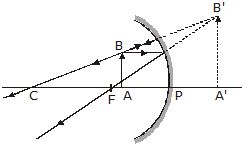
Q.1 If the magnification of a body of size 1 m is 2, what is the size of the image ? (2003)
Q.2 What is the power of a concave lens of focal length 25 cm ? (2004)
Q.3 What will be the focal length of a lens whose power is given as +2.0 D ? (2004)
Q.4 Where will the image be formed by a concave mirror when an object is placed between the pole and the focus point of the mirror ?(2005)
Q.5 What is the value of focal length of a plane mirror ? (2005)
Q.6 A ray of light is incident on a convex mirror as shown in fig. Redraw the above diagram after completing the path of the light ray after reflection from the mirror. (2006)
-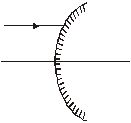
Q.7 Copy fig. in your answer book and show the direction of the light ray after reflection.(2008)
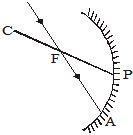
Q.8 The refractive index of diamond is 2.42. What is the meaning of this statement in relation to speed of light ? (2008)
Q.9 Draw fig. in your answer book and show the formation of image of the object AB with the help of suitable rays.
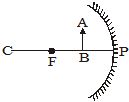
Q.10 Draw fig. in your answer book and show the formation of image of the object AB with the help of suitable rays.
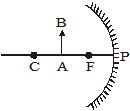
Q.11 Draw fig. in your answer book and show the formation of image with the help of suitable rays.
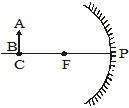
Q.12 Give the characteristics of image formed by a plane mirror. (2003)
Q.13 An object is placed at 0·06 m from a convex lens of focal length 0·1 m. Calculate the
position of the image? (2004)
Q.14 An object is placed at a distance of 20 cm in front of a convex mirror of radius of curvature 30 cm. Find the position and nature of the image. (2004)
Q.15 Light enters from air into diamond, which has a refractive index of 2.42. Calculate the speed of light in diamond. The speed of light in air is 3 × 108 ms–1. (2005)
Q.16 With the help of ray diagrams, show the formation of the images of an object by a concave mirror. When it is placed (i) beyond the centre of curvature (ii) at the centre of curvature. (2005)
Q.17 Draw ray diagrams to show the formation of image of an object by a concave mirror, when it is placed (i) between its centre of curvature C and focus F (ii) between pole P of mirror and its focus F. (2005)
Q.18 With respect to air, the refractive index of ice is 1·31 and that of rock salt is 1·54. Calculate the refractive index of rock salt w.r.t. ice. (2005)
Q.19 Draw ray diagrams to show the formation of image of an object by a concave lens when the object is placed. (i) at infinity (ii) between infinity and optical centre of the lens. (2005)
Q.20 Draw a ray diagram to show the position and nature of the image formed when an object is placed between focus F and pole P of a concave mirror. (2006)
Q.21 Draw ray diagrams to show the formation of the image of an object by a convex mirror, when it is placed (i) at infinity and (ii) between infinity and pole of the mirror. (2006)
Q.22 Draw a labelled ray diagram to locate the image of an object formed by a convex lens of focal length 20 cm when the object is placed 20 cm away from the lens.
Q.23 Explain with the help of a diagram, why a pencil partly immersed in water appears to be bent at the water surface. (2008)
Q.24 Draw the ray diagrams to represent the nature, position and relative size of the image formed by a convex lens for the object placed (i) at 2 F1 (ii) between F1 and optical centre O of the lens. (2008)
Q.25 Calculate the distance at which an object should be placed in front of a thin convex lens of focal length 10 cm to obtain a virtual image of double its size. (2003)
Q.26 A convex lens of focal length 40 cm is placed in contact with a concave lens of focal length 25 cm. What is the power the combination ? (2003)
Q.27 Find the position of an object, which when placed in front of a concave mirror of focal length 20 cm produces a virtual image, which is twice the size of the object. (2003)
Q.28 A concave lens made of a material of refractive index n1 is kept in a medium of refractive index n2. A parallel beam of light is incident on the lens. Complete the path of rays of light emerging from the concave lens if (i) n1 > n2 (ii) n1 = n2 (iii) n1 < n2. (2003)
Q.29 Find the position, nature and size of the image formed by a convex lens of focal length 20 cm of an object 4 cm high placed at a distance of 30 cm from it. (2004)
Q.30 A convex lens has focal length of 30 cm. Calculate at what distance should the object be placed from the lens so that it forms an image at 60 cm on the other side of the lens ? Find the magnification produced by the lens in this case. (2004)
Q.31 Find the position, nature and size of the image of an object 3 cm high placed at a distance of 9 cm from a concave of focal length 18 cm. (2004)
Q.32 An object 4 cm high is placed 40-0 cm in front of a concave mirror of focal length 20 cm. Find the distance from the mirror, at which a screen be placed in order to obtain a sharp image. Also find the size and nature of the image formed. (2005)
Q.33 An object is placed at a distance of 12 cm in front of a concave mirror. It forms a real image four times larger than the object. Calculate the distance of the image from the mirror.
Q.34 A 5.0 cm tall object is placed perpendicular to the principal axis of a convex lens of focal 20 cm. The distance of the object from the lens from the lens is 30 cm. By calculation, determine (i) the position (ii) the size of the image formed.
Q.35 An object 30 cm high is placed perpendicular to the principal axis of a concave lens of focal length 7.5 cm. The image is formed at a distance of 5.0 cm from the lens. Calculate (i) distance at which object is placed, and (ii) size and nature of image formed. (2006)
Q.36 A concave lens has focal length of 20 cm. At what distance from the lens a 5 cm tall object be placed so that it forms an image at 15 cm from the lens ? Also, calculate the size of the image formed. (Delhi, 2007)
Q.37 An object 50 cm tall is placed on the principal axis of a convex lens. Its 20 cm tall image is formed on the screen placed at a distance of 10 cm from the lens. Calculate the focal length of the lens.
· Fill in the blanks
1. A light wave of frequency 5 ×1014 Hz enters a medium of refractive index 1.5. In the medium the velocity of light wave is __________ and its wavelength is __________.
· Multiple choice question with one correct answers
1. When a ray of light enters a glass slab from air.
(A) its wavelength decreases
(B) its wavelength increases
(C) its frequency decreases
(D) neither its wavelength nor its frequency changes
2. An eye specialist prescribes spectracles having combination of convex lens of focal length 40 cm in contact with a concave lens of focal length 25 cm. The power of this lens combination in diopters is
(A) +1.5 (B) –1.5 (C) +6.67 (D) –6.67
3. A ray of light passes through four transparent media with refractive indices µ1, µ2, µ3 and µ4 as shown in the figure.
The surfaces of all media are parallel. If the emergent ray CD is parallel to the incident ray AB, we must have
(A) µ1 = µ2 (B) µ2 = µ3 (C) µ3 = µ4 (D) µ4 = µ1
4. A hollow double concave lens is made of very thin transparent material. It can be filled with air or either of two liquids L1 or L2 having refractive indices µ1 and µ2 respectively (µ2 > µ1 > 1). The lens will diverge a parallel beam of light if it is filled with
(A) air and placed in air (B) air and immersed in L1
(C) L1 and immersed in L2 (D) L2 and immersed in L1
5. A point object is placed at the centre of a glass sphere of radius 6 cm and refractive index 1.5. The distance of virtual image from the surface is
(A) 6 cm (B) 4 cm (C) 12 cm (D) 9 cm
6. What is the relation between the refractive indices µ1 and µ2 , if the behaviour of light ray is as shown in the figure.
(A) µ1 > µ2 (B) µ1 < µ2 (C) µ1 = µ2 (D) None of these
7. Which of the following lens can form image of an object on screen.
(A) Concave (B) Convex
(C) Both convex and concave (D) none of these
8. To obtain a dimnished image of an object, formed by a convex lens, where should the object must be placed?
(A) between F and 2F (B) At F (C) between infinity and 2F (D) at 2F
9. If object is placed between infinity and 2F of a convex lens, then image will form
(A) at F (B) between F and 2F (C) at 2 F (D) at infinity
· Assertion & Reason
Instructions: In the following questions as Assertion (A) is given followed by a Reason (R). Mark your responses from the following options.
(A) Both Assertion and Reason are true and Reason is the correct explanation of ‘Assertion’
(B) Both Assertion and Reason are true and Reason is not the correct explanation of ‘Assertion’
(C) Assertion is true but Reason is false
(D) Assertion is false but Reason is true
1. Assertion: A ray of light entering from glass to air suffers from change in frequency.
Reason: Velocity of light in glass is less than that in air
2. Assertion: A plane mirror has unity magnification.
Reason: In the case of plane mirror the distance of image is equal to the distance of object
3. Assertion: Convex mirror is used as a driver’s mirror.
Reason: Field view of a convex mirror is large.
4. Assertion: Focal length of a lens remain same if it is cut across the axis along XX´.
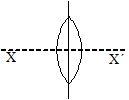
Reason: Both the refracting surfaces remain in tact if the lens is cut along X – X´ plane.
5. Assertion: Power of a lens is indirectly proportional to its focal length.
Reason: Units of focal length and power of a lens are same.
· Match the following (one to one)
Column-I and column-II contains four entries each. Entries of column-I are to be matched with some entries of column-II. Only One entries of column-I may have the matching with the same entries of column-II and one entry of column-II Only one matching with entries of column-I
1. Column I Column II
(A) Law of reflection (P) 1/focal length
(B) Law of refraction (Q) i = r
(C) Power of lens (R)
(D) Absolute refractive index of glass (S)
· Multiple choice question with one correct answers
1. A convex lens A of focal length 20 cm and a concave lens B of focal length 5 cm are kept along the same axis with a distance ‘d’ between them. If a parallel beam of light falling on a leaves B as a parallel beam, then d is equal to
(A) 25 cm (B) 20 cm (C) 15 cm (D) 10 cm
2. A thin rod of length f/3 is placed along the principal axis of a concave mirror of focal length f such that its image which is real and elongated, just touches the rod. The magnification is
(A) 2/3 (B) 3/2 (C) 3/5 (D) 5/3
3. Two thin lenses, when in contact, produce a combination of power +10 diopters. When they are 0.25 m apart, the power reduces to +6 diopters. The focal length of the lenses are
(A) 0.125 m. 0.5 m (B) 0.25 m, 0.5 m (C) 0.25 m, 0.75 m (D) none of these
4. A diminished image of an object is to be obtained on a screen 1.0 m from it. This can be achieved by appropriately placing.
(A) A convex lens of focal length more than 0.25 m(B) A convex mirror of suitable focal length
(C) A convex lens of focal length less than 0.25 m (D) A concave lens of suitable focal length
5. An observer can see through a pin-hole the top end of a thin rod of height h, placed as shown in the figure. The beaker height is 3h and its radius h. When the beaker is filled with a liquid up to a height 2h, he can see the lower end of the rod. Then the refractive index of the liquid is
(A) (B) (C) (D)
6. Two plane mirrors A and B are aligned parallel to each other as shown in the figure. A light ray is incident at an angle 30° at a point just inside one end of A. The plane of incidence coincides with the plane of the figure. The maximum number of times the ray undergoes reflections (including the first one) before it emerges out is

(A) 28 (B) 30 (C) 31 (D) 34
7. The size of the image of an object, which is at infinity, as formed by a convex lens of focal length 30 cm is 2 cm. If a concave lens of focal length 20 cm is placed between the convex lens and the image at a distance of 26 cm from the convex lens, calculate the new size of the image.
(A) 1.25 cm (B) 1.67 cm (C) 1.05 cm (D) 2 cm
8. A convex lens is in contact with concave lens. The magnitude of the ratio of their focal length is 2/3. Their equivalent focal length is 30 cm. What are their individual focal lengths?
(A) –15, 10 (B) –10, 15 (C) 75, 50 (D) –75, 50
9. A short linear object of length b lies along the axis of a concave mirror of focal length f at a distance u from the pole of the mirror. The size of the image is approximately equal to
(A) (B) (C) (D)
10. A concave mirror is placed on a horizontal table, with its axis directed vertically upwards. Let O be the pole of the mirror and C its centre of curvature. A point object is placed at C. It has a real image also located at C. If the mirror is now fillect with water, the image will be
(A) real, and will remain at C (B) real, and located at a point between C and ¥.
(C) virtual, and located at a point between C and O. (D) real, and located at a point between C and O.
· Multiple choice question with one or more than one correct answers
1. A converging lens is used to form an image on a screen. When the upper half of the lens is covered by an opaque screen.
(A) half the image will disappear (B) complete image will be formed
(C) intensity of the image will increase (D) intensity of the image will decrease
2. Which of the following form(s) a virtual and erect image for all positions of the object?
(A) convex lens (B) concave lens (C) convex mirror (D) concave mirror
· Comprehension
An object O is placed in denser medium. A light ray OA travels from denser to rarer medium. Refracted ray AD appears to come from O´. O´ is image of the object O.
Given that: OC = 2m, O´C = 2m/Ö3 and OB = 2m.
1. Value of sin i is
(A) 60° (B) 45° (C) 30° (D) None of these
2. Value of sin r is
(A) 60° (B) 45° (C) 30° (D) None of these
3. Refractive index of rarer medium w.r.t. denser medium is
(A) (B) (C) (D) None of these
4. Refractive index of denser medium w.r.t. rarer medium is
(A) (B) (C) (D) None of these
· Match the following (one to many)
Column-I and column-II contains four entries each. Entries of column-I are to be matched with some entries of column-II. One or more than one entries of column-I may have the matching with the same entries of column-II and one entry of column-II may have one or more than one matching with entries of column-I
1. Column I Column II
(A) Straight line which is normal to (P) will passes through principal focus (F)
the mirror at its pole (p)
(B) A ray, parallel to the principal axis (Q) Focal length (f)
of concave mirror after reflection
(C) The distance between the pole and (R) principal axis
the principle focus of a mirror
(D) A straight line passing through the (S) Half of radius of curvature (c)
pole (p) and the centre of curvature (c)
Q.1 A mirror forms a virtual image of a real object.
(A) It must be a convex mirror.
(B) It must be a concave mirror.
(C) It must be a plane mirror.
(D) It may be any of the mirrors mentioned above.
Q.2 The angle of incidence is the angle between
(A) the incident ray and the surface of the mirror
(B) the reflected ray and the surface of the mirror
(C) the normal to the surface and the incident ray
(D) the normal to the surface and the reflected ray
Q.3 The angle of reflection is the angle between
(A) the incident ray and the surface of the mirror
(B) the reflected ray and the surface of the mirror
(C) the normal to the surface and the incident ray
(D) the normal to the surface and the reflected ray
Q.4 An object is placed at the centre of curvature of a concave mirror. The distance between its image and the pole is
(A) equal to f
(B) between f and 2f
(C) equal to 2f
(D) greater than 2f
Q.5 An object of size 2.0 cm is placed perpendicular to the principal axis of a concave mirror. The distance of the object from the mirror equals the radius of curvature. The size of the image will be
(A) 0.5 cm (B) 1.5 cm
(C) 1.0cm (D) 2.0 cm
Q.6 The magnification m of an image formed by a spherical mirror is negative. It means, the image is
(A) smaller than the object
(B) larger than the object
(C) erect
(D) inverted
Q.7 A point object is placed on the principal axis of a spherical mirror. The object-distance u is
(A) definitely negative
(B) definitely positive
(C) positive if the object is to the left of the centre of curvature
(D) positive if the object is to the right of the centre of curvature
Q.8 is valid
(A) for convex mirrors but not for concave mirrors
(B) for concave mirrors but not for convex mirrors
(C) for both convex and concave mirrors
(D) neither for convex mirrors nor for concave mirrors
Q.9 A ray of light is incident on a concave mirror. If it is parallel to the principal axis, the reflected ray will
(A) pass through the focus
(B) pass through the centre of curvature
(C) pass through the pole
(D) retrace its path
Q.10 If an incident ray passes through the centre of curvature of a spherical mirror, the reflected ray will
(A) pass through the pole
(B) pass through the focus
(C) retrace its path
(D) be parallel to the principal axis
Q.11 To get an image larger than the object, one can use
(A) a convex mirror but not a concave mirror
(B) a concave mirror but not a convex mirror
(C) either a convex mirror or a concave mirror
(D) a plane mirror
Q.12 A ray of light travelling in air falls obliquely on the surface of a calm pond. It will
(A) go into the water without deviating from its path
(B) deviate away from the normal
(C) deviate towards the normal
(D) turn back on its original path
Q.13 A ray of light goes from a medium of refractive index m1 to a medium of refractive index m2. The angle of incidence is i and the angle of refraction is r. Then, sin i/sin r is equal to
(A) m1 (B) m2
(C) (D)
Q.14 A thin lens and a spherical mirror have a focal length of + 15 cm each.
(A) Both are convex.
(B) The lens is convex and the mirror is concave.
(C) The lens is concave and the mirror is convex.
(D) Both are concave.
Q.15 A convex lens
(A) is thicker at the middle than at the edges (B) is thicker at the edges than at the middle
(C) has uniform thickness everywhere (D) is called a diverging lens
Q.16 A convex lens forms a virtual image when an object is placed at a distance of 18 cm from it. The focal length must be
(A) Greater than 36 cm
(B) Greater than 18 cm
(C) Less than 36 cm
(D) Less than 18 cm
Q.17 An object is placed before a convex lens. The image formed
(A) is always real
(B) may be real or virtual
(C) is always virtual
(D) is always erect
Q.18 An object is placed before a concave lens. The image formed
(A) is always erect
(B) may be erect or inverted
(C) is always inverted
(D) is always real
Q.19 A lens has a power of +0.5 D. It is
(A) a concave lens of focal length 5 m (B) a convex lens of focal length 5 cm
(C) a convex lens of focal length 2 m (D) a concave lens of focal length 2 m
Q.20 A deviation in the path of a ray of light can be produced
(A) by a glass prism but not by a rectangular glass slab
(B) by a rectangular glass slab but not by a glass prism
(C) by a glass prism as well as a rectangular glass slab
(D) neither by a glass prism nor by a rectangular glass slab
Q.21 If you want to see your full image then the, minimum size of the plane mirror
(A) should be of your height.
(B) should be half of your height.
(C) should be twice of your height. (D) depends upon your distance from the mirror.
Q.22 An object A is placed at a distance d in front of a plane mirror. If one stands directly behind the object at a distance S from the mirror, then the distance of the image.of A from the individual is
(A) 2 S (B) 2 d
(C) S + d (D) S + 2d
Q.23 A light bulb is placed between two plane mirrors inclined at an angle of 60°. The number of images formed are
(A) 6 (B) 5
(C) 4 (D) 2
Q.24 A person of height 1.8 standing at the centre of a room having equal dimensions of 10 m wishes to see the full image of the back wall in the mirror fixed on the front wall. The minimum height of the plane mirror needed for this purpose is
(A) 0.9 m (B) 1.8 m
(C) m (D) 10 m
Q.25 Two plane mirrors inclined at an angle to one another have an object placed between them. If five images of the object are observed, the maximum possible angle between the mirrors is
(A) 45° (B) 60°
(C) 72° (D) 90°
Q.26 In case of a thick plane mirror multiple images are formed. The brightest of all the images will be
(A) first (B) second
(C) third (D) fourth
Q.27 Indicate the only correct statement.
(A) The image formed by a convex mirror can be taken on the screen.
(B) A convex mirror can produce a parallel beam of light from a point source. .
(C) The image of an object placed at the focus of a convex mirror will be formed at infinity.
(D) A concave mirror can never form a diminished virtual image.
Q.28 The focal length of a concave mirror is f and the distance from the object to the principal focus is x. The magnification obtained will be
(A) (f + x)/f (B) f/x
(C) (D) f2/x2
Q.29 In a museum a child walks towards a large concave mirror. He will see that
(A) his real, erect image goes on decreasing in size.
(B) his virtual, erect image goes on increasing in size.
(C) his real, inverted image goes on increasing in size and suddenly it becomes virtual, erect and magnified.
(D) his real, erect Image goes on diminishing in size and suddenly it becomes virtual, erect and magnified.
Q.30 The magnification of an object placed 10 cm from a convex mirror of radius of curvature 20 cm will be
(A) 0.2 (B) 0.5
(C) 1 (D) infinity
Q.31 A concave mirror of focal length 10 cm produces an image five times as large as the object. If the image is in front of the mirror, the distance of the object from the mirror will be
(A) 10 cm (B) 12 cm
(C) 16 cm (D) 20 cm
Q.32 To form an image twice the size of the object, using a convex lens of focal length 20 cm, the object distance must be –
(A) < 20 cm
(B) > 20 cm
(C) < 20 cm and between 20 cm and 40 cm (D) Cannot say
Q.33 Refractive index of glass w.r.t. air is 3/2. What is the refractive index of air w.r.t glass?
(A) 2/3 (B) 1
(C) Zero (D) (3/2)2
Q.34 The mirage is formed due to
(A) reflection
(B) refraction
(C) total internal reflection
(D) dispersion
Q.35 A glass prism has refractive index 1.5 and the refracting angle 90° If a ray falls on it at an angle of incidence of 30°, then the angle of emergence will be
(A) 60°
(B) 45°
(C) 30°
(D) the ray will not emerge at all
Q.36 When monochromatic light passes from vacuum to a material medium and vice versa; which of the following characteristics of light beam does not change?
(A) velocity (B) intensity
(C) wavelength (D) frequency
Q.37 A piece of glass when immersed in a transparent solution of refractive index 1.48 becomes almost invisible. The refractive index of glass used is
(A) zero (B) 1
(C) 1.48 (D) infinite
Q.38 Which of the following conditions are necessary for total internal reflection to take place at the boundary of two optical media?
I. Light is passing from optically denser medium to optically rarer medium.
II. Light is passing from optically rarer medium to optically denser medium.
III. Angle of incidence is greater than the critical angle.
IV. Angle of incidence is less than the critical angle.
(A) I and III only (B) II and IV only (C) III and IV only (D) I and IV only
Q.39 The speed of light in vacuum is 3.0×108m/s. If the refractive index of a transparent liquid is 4/3, then the speed of light in the liquid is
(A) 2.25 × 108 m/s
(B) 3 x 108 m/s
(C) 4 × 108 m/s
(D) 4.33 × 108 m/s
Q.40 The refractive indices of water and glass are 4/3 and 3/2 respectively. The refractive index of water with respect to glass is
(A) (B) 2
(C) (D)
Q.41 Which of the following can be used to form a virtual image of an object?
I. convex lens
II. concave lens
III. concave mirror
(A) II only (B) II and III only (C) I and III only (D) I, II and III
Q.42 An object is placed in front of a concave mirror focal length f. An erect image is formed with a magnification of 2. To obtain real image with the same magnification, the object has to be moved through a distance of: [NTSE]
(A) f/2 (B) f
(C) 3f/2 (D) 2f/3
Q.43 A girl standing in front of a vertical plane mirror, is able to see herself only upto her knees. She can see the lower part of her legs, if:-[NTSE]
(A) she moves towards the mirror
(B) she moves away from the mirror
(C) she bends down
(D) she stands on a stool
Q.44 Image of an object in a concave mirror is observed on a screen first by keeping the object at position A and then at another position B. The magnifications mA and mB in the two cases were determined. If
mAmB = 1, then: [NTSE]
(A) both the position A and B are beyond the centre of curvature C.
(B) both the position A and B are between C and F.
(C) one of the position A and B is between pole P and focus F of the mirror.
(D) one of the positions A and B is between F and C while the other is beyond C.
Q.45 Light incident on a rotating mirror M is returned to a fixed mirror N placed 22.5 km away from M. The fixed mirror reflects it back to M (along the same path) which in turn reflects the light again along a direction that makes an angle of 27° with the incident direction. The speed of rotation of the mirror is: [NTSE]
(A) 250 revolutions s–1
(B) 500 revolutions s–1
(C) 1000 revolutions s–1
(D) 125 revolutions s–1
Q.46 Which of the following phenomena can be demonstrated by light. But not with sound waves in an air column? [NTSE]
(A) Reflection (B) Diffraction
(C) Refraction (D) Polarization
Q.47 An object is place at a distance x1 from the focus of a concave mirror. Its real image is formed at a distance x2 from the focus. Hence, the focal length of the mirror is: [NTSE]
(A) (B)
(C) (D)
Q.48 In the figure shown below. A, B, C are points on the principal axis of a spherical mirror/lens. Which of the following arrangements will produce image I I1 of the object O O1?[NTSE]
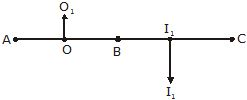
(A) a convex mirror at A
(B) a concave mirror at C
(C) a concave mirror at A
(D) a concave lens at B
Q.49 An object is placed 0.40m from one of the two lenses L1 and L2 of focal length 0.20m and 0.10m respectively as depicted in the figure. The separation between the lenses is 0.30m.
The final image formed by this two lens system is at [NTSE]

(A) 0.13 m to the right of the second lens (B) 0.05 m to the right of the second lens
(C) 0.13 m to the left of the second lens (D) Infinity
Q.50 A ray of light enters a slab of material with increasing refractive index. Four possibilities of the trajectory of the ray are shown below.
The correct choice is: [NTSE]
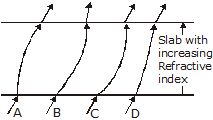
(A) A (B) B
(C) C (D) D
Q.51 In the figure below a ray of light travelling in a medium of refractive index m passes through two different connected rectangular blocks of refractive indices m1 and m2 (m2 > m1).[NTSE]
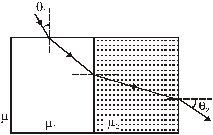
The angle of incidence q1 is increased slightly. Then angle q2.
(A) increases
(B) decreases
(C) remains the same
(D) increases or decreases depending on the value of (m1/m2).
Q.52 A light source is placed 100cm away from a screen. A converging lens placed at a certain position between the source and the screen focuses the image of the source on the screen. The lens is moved a distance of 40cm and it is found that it again focuses the image of the source on the screen. The focal length of the lens is: [NTSE]
(A) 21 cm (B) 30 cm
(C) 40 cm (D) 67 cm
Q.53 Which of the following does NOT represent correct refraction? [NTSE]
(A) (B)
(B) 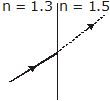
(C) 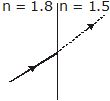 (D)
(D) 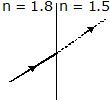
1. 2 × 108 m/s, 0.4 × 10–6 m
1. (A) 2. (B) 3. (D) 4. (D) 5. (B) 6. (B)
7. (B) 8. (C) 9. (B)
1. (D) 2. (A) 3. (A) 4. (A) 5. (C)
1. (A)-(Q), (B)-(R), (C)-(P), (D)-(S)
1. (C) 2. (B) 3. (A) 4. (C) 5. (B) 6. (C)
7. (B) 8. (A) 9. (D) 10. (D)
1. (B,D) 2. (B,C)
1. (B) 2. (A) 3. (A) 4. (B)
1. (A)-(R), (B)-(P), (C)-(Q,S), (D)-(P,R)
1. D 2. C 3. D 4. C 5. D 6. D 7. A
8. C 9. A 10. C 11. B 12. C 13. D 14. A
15. A 16. B 17. B 18. A 19. C 20. A 21. B
22. C 23. B 24. C 25. C 26. B 27. D 28. B
29. C 30. B 31. B 32. C 33. A 34. C 35. D
36. D 37. C 38. A 39. A 40. A 41. D 42. B
43. B 44. D 45. A 46. D 47. B 48. C 49. D
50. C 51. B 52. A 53. B